Products
-
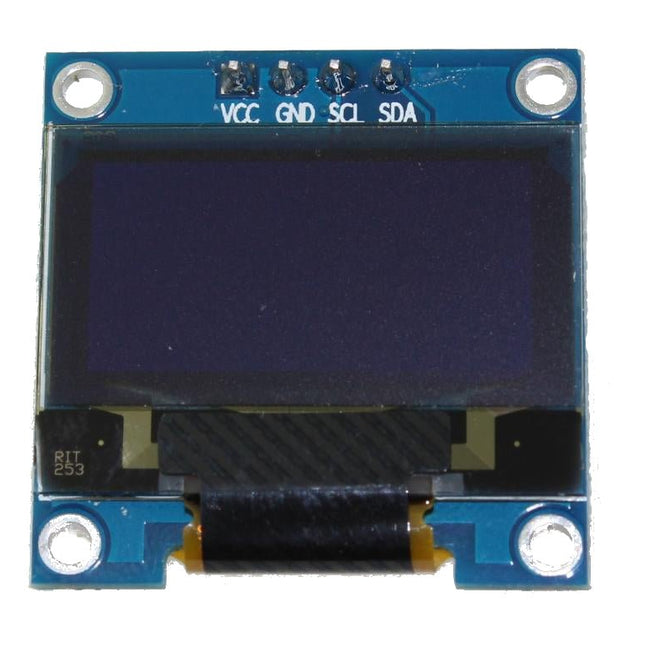
Kuongshun 0.96" OLED Display (Blue, I²C, 4-Pin)
This 0.96-inch monochrome graphical OLED display, with a resolution of 128 x 32 pixels, is mounted on a 28 x 28 mm PCB. The active display area is 11 x 23 mm. It includes a 4-pin connector that supports the I²C bus (with SCL and SDA signals). The display is compatible with both 5 V and 3.3 V applications. Specifications Display size: 0.96" Resolution: 128 x 32 pixels Board size: 28 x 28 mm Effective display surface: 11 x 23 mm Visual angle: >160° Input voltage: 3.3 V ~ 6 V Wide voltage support: 3.3 V, 5 V Viewing angle: >160° Drive IC: SSD1306 Operating temperature: -30 to 80°C I²C Signals: SCL, SDA I²C address: 0x78 (or 0x3c, default) or 0x7a (or 0x3d). Note: I²C addresses can (unfortunately) be specified in two ways: including R/W bit or not. Therefore 0x78 (0x7a) including the R/W bit is equal to 0x3c (0x3d) without R/W bit. OLED Advantages Smaller volume Ultra-low power consumption High Contrast Display dot self-luminous Wide voltage support Warning: The display’s glass is fragile, please be careful while handling it. If the glass is broken, the screen will not work well.
-
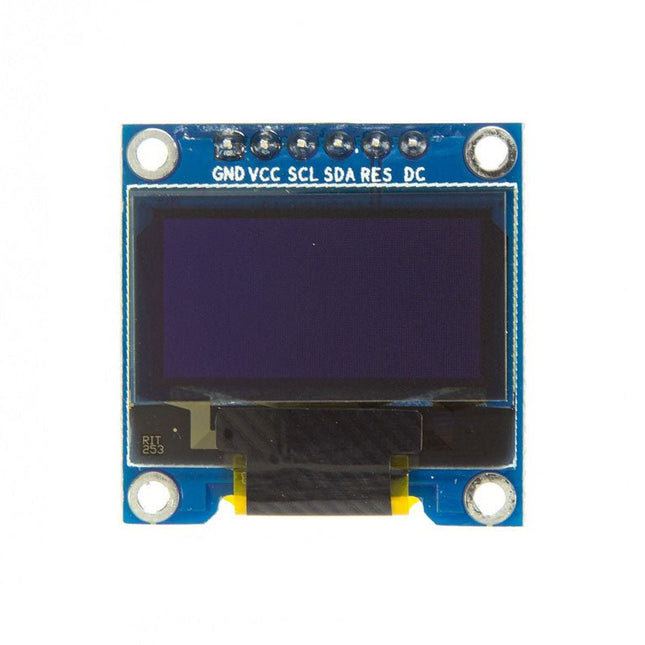
Kuongshun 0.96" OLED Display for Arduino (128x64)
Specifications Size: 0.96 inch Resolution: 128 x 64 Visual Angle: >160 ° Input Voltage: 3.3 V ~ 6 V Wide voltage support: 3.3 V, 5 V Viewing angle: >160 Only Need 2 I/O Port to Control Drive IC: SSD1306 Operating temperature: -30 °C to 80 °C OLED Advantages Smaller volume Ultra-low power consumption High contrast Display dot self-luminous Broad voltage support Independent communication method via SPI or IIC 128x64 Dot matrix Broad visual angle: maximum visual angle 160° Industrial-grade operating temperature: -30 ~ 70 °C Warning: The display’s glass is very thin, please be careful while using it. If The glass is broken, display will not work well.
-
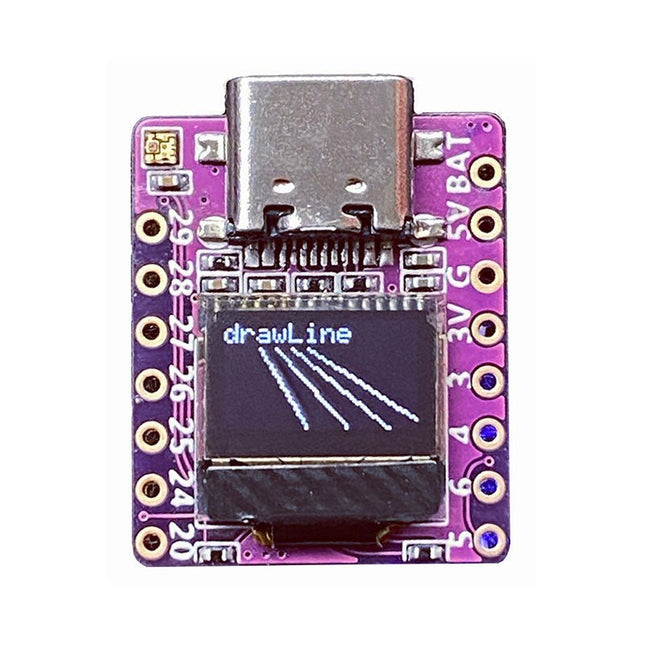
01Space 01Space RP2040-0.42LCD Development Board
Arduino, MicroPython, and CircuitPython-compatible compact development board powered by Raspberry Pi RP2040 RP2040-0.42LCD is a high-performance development board with integrated 0.42" LCD (70x40 resolution) with flexible digital interfaces. It incorporates Raspberry Pi's RP2040 microcontroller chip. The RP2040 features a dual-core Arm Cortex-M0+ processor clocked at 133 MHz with 264 KB internal SRAM and 2 MB flash storage. Specifications SoC Raspberry Pi RP2040 dual-core Cortex-M0+ microcontroller at up to 125 MHz, with 264 KB SRAM Storage 2 MB SPI flash Display 0.42-inch OLED USB 1x USB Type-C port for power and programming Expansion – Qwiic I²C connector– 7-pin and 8-pin headers with up to 11x GPIOs, 2x SPI, 2x I²C, 4x ADC, 1x UART, 5 V, 3.3 V, VBAT, GND Misc – Reset and Boot buttons– RGB LED, power LED Power supply – 5 V via USB-C port or Vin– VBAT pin for battery input– 3.3 V regulator with 500 mA peak output Dimensions 23.5 x 18 mm Weight 2.5 g Downloads GitHub
€ 19,95
Members € 17,96
-
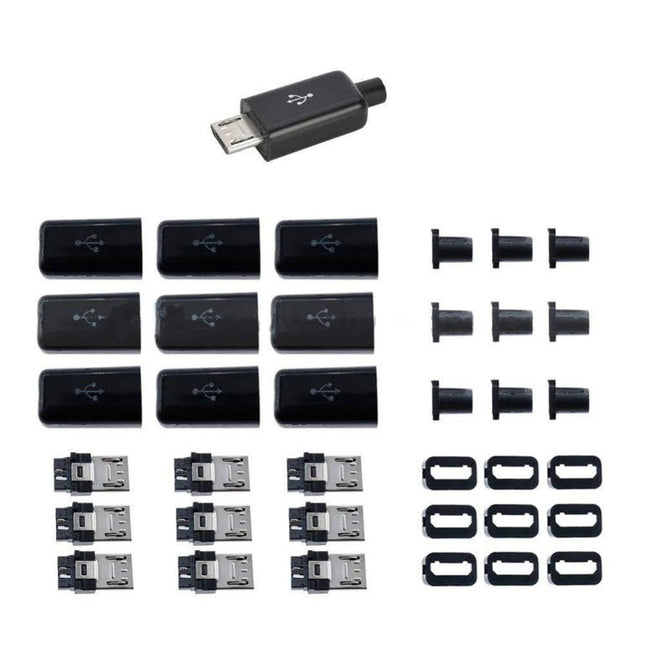
Kuongshun 10x Micro-USB B Male Plug Connector Kit with Plastic Cover
Specifications Material: Plastic + Steel Quantity: 10 Pieces Dimensions: 0.71 x 0.39 x 0.28" Weight: 0.5 oz/pc
€ 7,95
Members € 7,16
-
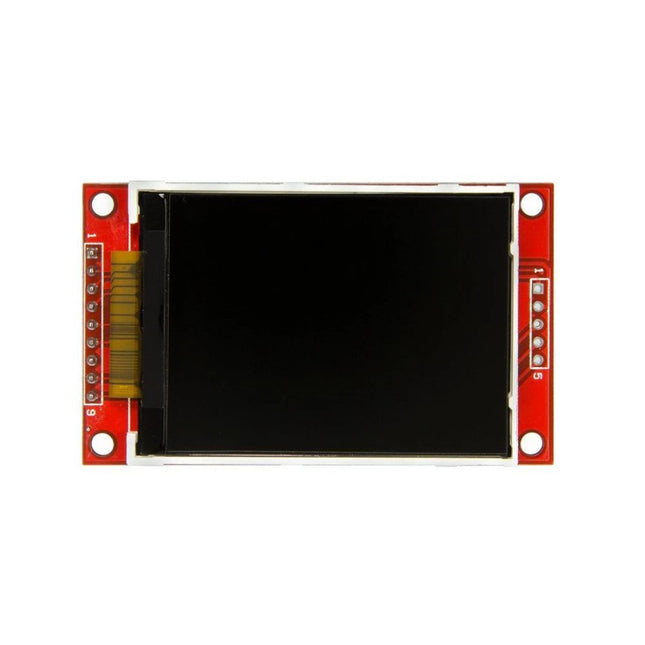
Kuongshun 2.2" SPI TFT Display Module ILI9341 (240x320)
ILI9341 is a 262144-color single-chip SOC driver for a TFT liquid crystal display with resolution of 240x320 dots (RGB), comprising a 720-channel source driver, a 320-channel gate driver, 172800 bytes GRAM for graphic display data of 240x320 dots (RGB), and power supply circuit.ILI9341 supports parallel 8-/9-/16-/18-bit data bus MCU interface, 6-/16-/18-bit data bus RGB interface and 3-/4-line serial peripheral interface (SPI).The moving picture area can be specified in internal GRAM by window address function. The specified window area can be updated selectively, so that moving picture can be displayed simultaneously independent of still picture area.ILI9341 can operate with 1.65V ~ 3.3V I/O interface voltage and an incorporated voltage follower circuit to generate voltage levels for driving an LCD.ILI9341 supports full color, 8-color display mode and sleep mode for precise power control by software and these features make the ILI9341 an ideal LCD driver for medium or small size portable products such as digital cellular phones, smart phone, MP3 and PMP where long battery life is a major concern.Features Display resolution: 240 x 320 (RGB) Output: 720 source outputs | 320 gate outputs | Common electrode output (VCOM) a-TFT LCD driver with on-chip full display RAM: 172,800 bytes System Interface 8-bits, 9-bits, 16-bits, 18-bits interface with 8080-Ⅰ/8080- Ⅱ series MCU 6-bits, 16-bits, 18-bits RGB interface with graphic controller 3-line / 4-line serial interface Display mode: Full color mode (Idle mode OFF): 262K-color Reduced color mode (Idle mode ON): 8-color Power saving modes: Sleep mode Deep standby mode On chip functions: VCOM generator and adjustment Timing generator Oscillator DC/DC converter Line/frame inversion 1 preset Gamma curve with separate RGB Gamma correction Content Adaptive Brightness Control MTP (3 times): 8-bits for ID1, ID2, ID3 7-bits for VCOM adjustment Low-power consumption architecture Low operating power supplies: VDDI = 1.65V ~ 3.3V (logic) VCI = 2.5V ~ 3.3V (analog) LCD Voltage drive: Source/VCOM power supply voltage AVDD - GND = 4.5V ~ 5.5V VCL - GND = -2.0V ~ -3.0V Gate driver output voltage VGH - GND = 10.0V ~ 20.0V VGL - GND = -5.0V ~ -15.0V VGH - VGL 3 ≦ 2V VCOM driver output voltage VCOMH = 3.0V ~ (AVDD – 0.5)V VCOML = (VCL+0.5)V ~ 0V VCOMH - VCOML ≦ 6.0V Operate temperature range: -40℃ to 85℃
€ 22,95
Members € 20,66
-
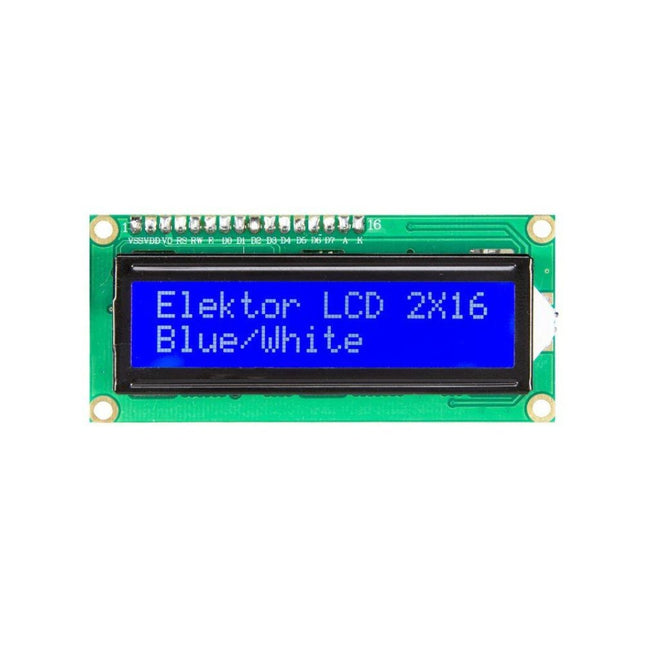
Kuongshun 2x16 Character LCD Module (blue/white)
2x16 Character LCD Module (blue/white) Pin No. Pin Name Descriptions 1 VSS Ground 2 VDD Supply voltage for logic 3 V0 Input voltage for LCD 4 RS Data / Instruction Regster Select (H : Data signal, L : Instruction signal) 5 R/W Read / Write (H : Read mode, L : Write mode) 6 E Enable signal 7 DB0 Data bit 0 8 DB1 Data bit 1 9 DB2 Data bit 2 10 DB3 Data bit 3 11 DB4 Data bit 4 12 DB5 Data bit 5 13 DB6 Data bit 6 14 DB7 Data bit 7 15 LED_A Backlight Anode 16 LED_K Backlight Cathode
€ 5,95
Members € 5,36
-

Elektor Digital 303 Circuits (E-book)
Like its predecessors in the 300 series of electronics projects books, 303 Circuits is aimed at the active electronics enthusiast, professional or amateur. Since the series was started in the early 1980s, many thousands of readers have found in these books that new approach, new concept, or new circuit they were looking for. In 303 Circuits you will find new ideas, new concepts and new circuits covering the gamut of electronics. The book is arranged in subject sections to make it easier for you to find the circuit or idea you are looking for.
€ 29,95
Members € 23,96
-
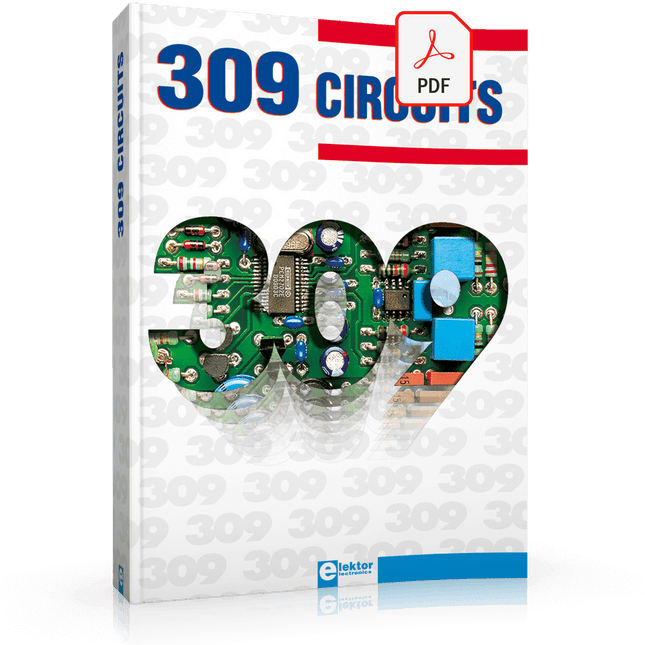
Elektor Digital 309 Circuits (E-book)
The present tenth edition of the popular ʻ30x Circuitsʼ series of books once again contains a comprehensive variety of circuits, sub-circuits, tips and tricks and design ideas for electronics. These 309 Circuits again offer a representative indication of present-day electronics. Regular ʻ30x seriesʼ enthusiasts will no doubt know what to expect: 309 Circuits contains many fully elaborated electronics projects. In addition, there are numerous ideas, each of which with a potential for use in your own research, projects and applications. Among many other inspiring topics, the following categories are well presented in this book: test & measurement; RF (radio); computers and peripherals; audio & video; hobby and modelling; microcontrollers; home & garden; power supplies & battery chargers; etcetera. 309 Circuits has been compiled from the contents of Elektor Electronics' Summer Circuits editions for the years 2003, 2004 and 2005. Summer Circuits is the annual double issue of Elektor Electronics magazine covering the months of July and August.
€ 29,95
Members € 23,96
-
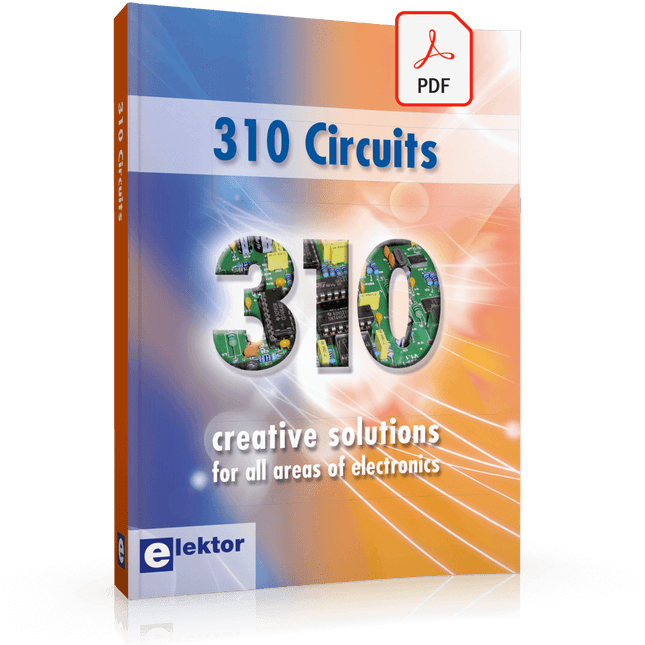
Elektor Digital 310 Circuits (E-book)
310 Circuits – is the 11th volume in Elektor’s renowned ‘Three Hundred’ series. 310 circuits, tips and design ideas in one book form a treasure trove for every area of electronics: audio and video, hobby and modelling, RF techniques, home and garden, test and measurement, microcontrollers, computer hardware and software, power supplies and chargers – plus of course everything else that does not seem to belong in any of these categories. 310 Circuits – contains many complete solutions as well as useful starting points for your own projects. Both categories and anything in between represent a veritable fountain of inspiration for cultivating your own ideas and learning about electronics. 310 Circuits – is a compilation of articles from ‘Summer Circuits’ editions for the years 2006, 2007 and 2008. ‘Summer Circuits’ covers the publication months July and August of Elektor magazine. 310 Circuits – is a must-have book for every creative electronics enthusiast, be it professional, enthusiast or student. 310 Circuits – for the first time has a section exclusively on robots and robotics.
€ 29,95
Members € 23,96
-
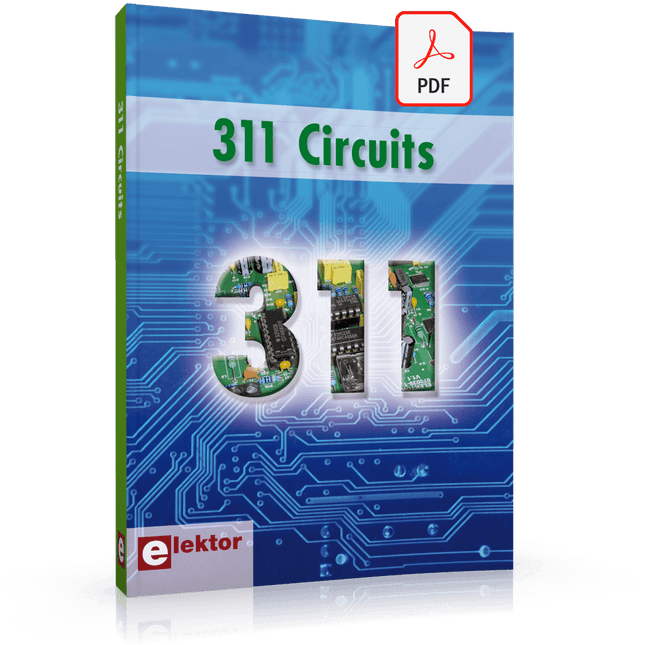
Elektor Digital 311 Circuits (E-book)
311 Circuits is the twelfth book in Elektor’s celebrated ‘300’ series. An immense source of inspiration for all electronics enthusiasts and professionals, this book deserves a place not far from the workbench. This book contains circuits, design ideas, tips and tricks from all areas of electronics: audio & video, computers & microcontrollers, radio, hobby & modelling, home & garden, power supplies & batteries, test & measurement, software, not forgetting a section ‘miscellaneous’ for everything that doesn’t fit in one of the other categories. 311 Circuits presents complete solutions for numerous problems, as well as starting points for your own creations. 311 Circuits has been compiled from the 2009, 2010 and 2011 ‘Summer Circuits’ double editions of Elektor magazine. The book is mostly based on readers’ contributions, supplemented by circuits engineered and developed in the Elektor Labs.
€ 29,95
Members € 23,96
-
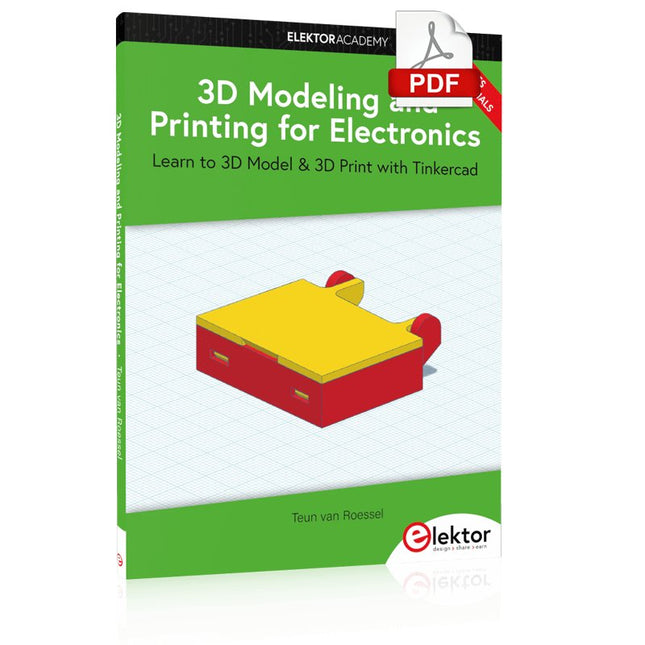
Elektor Digital 3D Modeling and Printing for Electronics (E-book)
Learn to 3D Model & 3D Print with Tinkercad With this book and the complementary videos, you’ll be 3D printing in no time at all. This course is meant to have you make casings for electronic components but also goes into optimizing your print technique as well as adding a little flair to your 3D creations. The course is perfect for you if you just bought your (first) 3D printer and want to print your own designs as soon as possible while also being able to get more background information. You’ll get to know the workings of a 3D printer and what software to use to model your object, not forgetting to make it print perfectly. We’ll even use the magic of 3D printing to create things that appear impossible to make (this fast and simple) with any other rapid-prototyping technique. At the end of this course, it’ll be second nature for you to design an object for 3D printing and fine-tune your print-setting to get the perfect print! The book includes the following 7 video tutorials: Introduction Basic 3D modeling for 3D printing Modeling a casing Post-processing Pushing the limits Movable parts Snap fits
€ 32,95
Members € 26,36
-

BerryBase 40-pin GPIO Header for Raspberry Pi (color-coded)
This color-coded pin header is ideal for use with Raspberry Pi. All pins are color-coded with corresponding functions making prototyping and hacking easier. Specifications Suitable for all Raspberry Pi models with GPIO 2 pin rows with 20 pins each 2.54 mm pin spacing (pitch) Pin height: 3/6 mm Total height: approx. 11 mm Colors/Functions Orange = 3.3 V Red = 5 V Pink = I²C Purple = UART Blue = SPI Yellow = DNC Green = GPIO Black = GND (Ground)
€ 2,95€ 1,95
Members identical
-
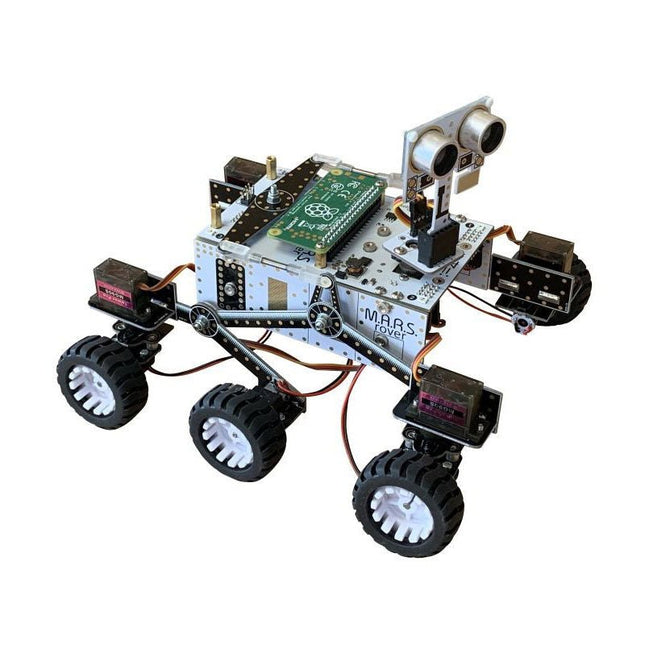
4tronix 4tronix M.A.R.S. Rover Robot Kit for Raspberry Pi Zero
Inspired by NASA's “Curiosity” and “Perseverance” Mars Rovers, this innovative M.A.R.S. Rover is an autonomous vehicle designed to drive around on rough terrain here on Earth. It uses the same rocker arm, bogey and differential arm mechanism. M.A.R.S. is an acronym for 'Mobile Autonomous Robotic System'. Features 6 Motors: 80 rpm 6 V, N20 micro gear motors 4 Servos: MG90S metal gear analog micro servos 4 FireLEDs Ultrasonic distance sensor on steerable mast Total number of special PCBs: 30 Number of different PCB designs: 11 Length: 200 mm Width: 185 mm Height with Mast: 170 mm Weight excluding Raspberry Pi Zero and batteries: 460 g There is a Python library module for the Raspberry Pi Zero that makes it easy to control the unit. Required Raspberry Pi Zero 4 rechargeable AA batteries Downloads Assembly of 4tronix M.A.R.S. Rover Kit Programming M.A.R.S. Rover on Raspberry Pi Zero Coding using Microsoft Makecode on GitHub
-
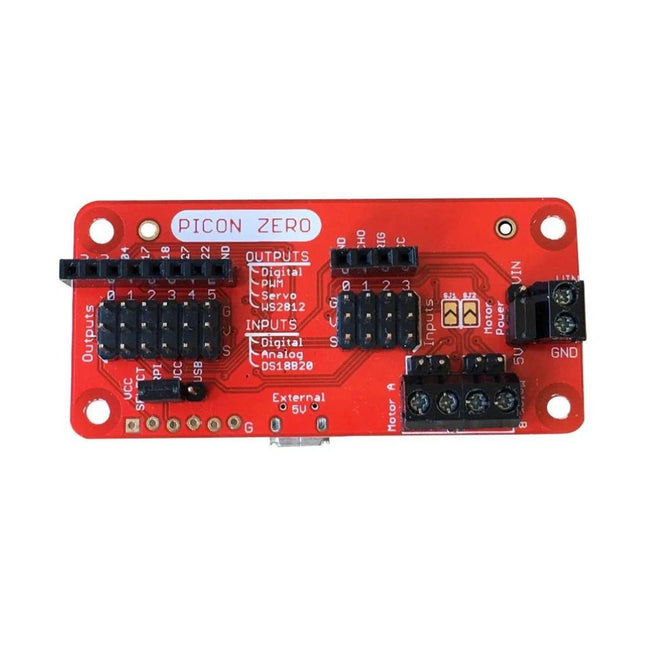
4tronix 4tronix Picon Zero v1.3 - Intelligent Robotics Controller for Raspberry Pi
The Picon Zero is an add-on for the Raspberry Pi. It has the same size as a Raspberry Pi Zero, making it ideal to function as a pHat. Of course, it can be used on any other Raspberry Pi via a 40-pin GPIO connector. As well as two full H-Bridge motor drivers, the Picon Zero has several Input/Output pins giving you multiple configuration options. That allows you to easily add outputs or analog inputs to your Raspberry Pi without any complicated software or kernel-specific drivers. At the same time, it opens up 5 GPIO pins from the Raspberry Pi, and it provides the interface for an HC-SR04 ultrasonic distance sensor. The Picon Zero comes with all components, including the headers and screw terminals, fully soldered. Soldering isn't required. You can use it right out of the box. Features pHat format PCB: 65 mm x 30 mm Two full H-Bridge motor drivers. Drive up to 1.5 A continuously per channel, at 3 V - 11 V. Each motor output has both a 2-pin male header and a 2-pin screw terminal. The motors can be powered from the Picon Zero's 5 V or an external power source (3 V - 11 V). The Picon Zero's 5 V can be selected to be from the Raspberry Pi's 5 V line, or a USB connector on the Picon Zero. That means that you can effectively have 2 USB battery banks: one to power the servos and motors on the Picon Zero and the other to power the Pi. 4 Inputs that can accept up to 5 V. These inputs can be configured as follows: Digital inputs Analog inputs DS18B20 DHT11 6 Outputs that can drive 5 V and be configured as: Digital Output PWM Output Servo NeoPixel WS2812 All Inputs and Outputs use GVS 3-pin male headers. 4-pin female header that connects directly to an HC-SR04 ultrasonic distance sensor. 8-pin female header for Ground, 3.3 V, 5 V, and 5 GPIO signals allowing you to add their additional features.
€ 18,95
Members € 17,06
-
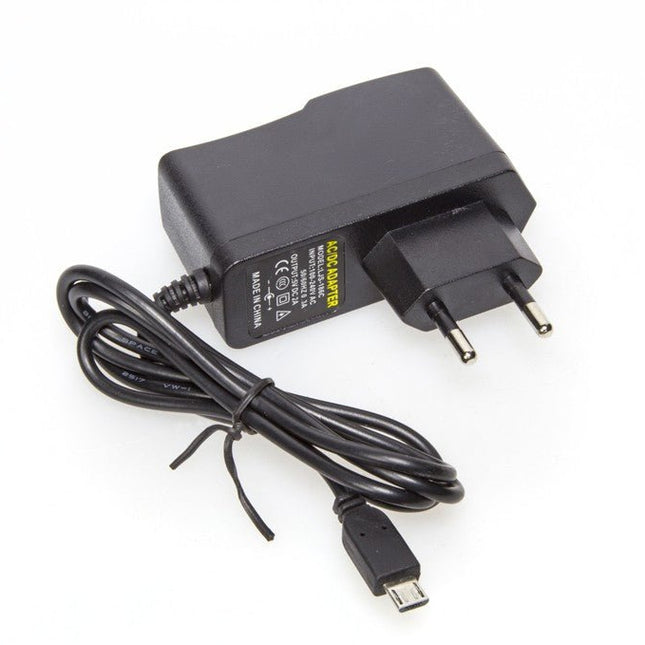
Kuongshun 5 V/2 A Micro-USB Power Supply (EU)
5 V/2 A Micro-USB Power Supply (EU)
€ 7,95
Members € 7,16
-
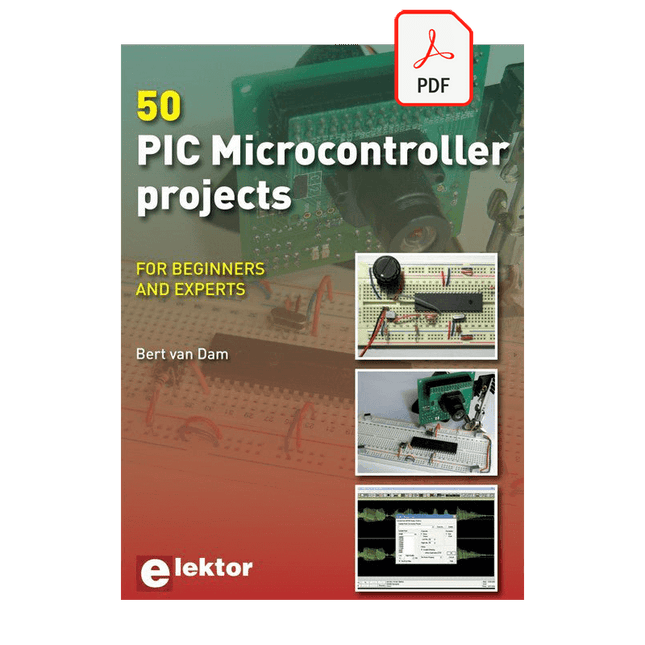
Elektor Digital 50 PIC Microcontroller Projects (E-book)
This book contains 50 fun and exciting projects for PIC microcontrollers such as a laser alarm, USB teasing mouse, eggtimer, youth repellent, soundswitch, capacitive liquid level gauge, 'finger in the water' sensor, guarding a room using a camera, mains light dimmer (110-240 volts), talking microcontroller and much more. Several different techniques are discussed such as relay, alternating current control including mains, I²C, SPI, RS232, USB, pulse width modulation, rotary encoder, interrupts, infrared, analog-digital conversion (and the other way around), 7-segment display and even CAN bus. You can use this book to build the projects for your own use. The clear explanations, schematics and even pictures of each project make this a fun activity. For each project the theory is discussed and why the project has been executed in that particular way. That means you can also use this book as a studybook, or as basis for larger and more complicated projects. All projects use a breadboard so modification and expansion is easy. Three PIC microcontrollers are used, the 16f877A, 18f4455 and 18f4685. It is also discussed how you can migrate your project from one microcontroller to another – 15 types are supported - including two example projects. All software that is used in this book can be downloaded for free. That also applies to the open source programming language JAL. This powerful and yet easy to learn language is used by hobbyists as well as professionals. This book can also be used as a reference guide. It explains all JAL commands, as well as the expansion libraries. Using the index you can easily find example projects that illustrate the use of these commands. Even when you have built all projects in this book you will still want to keep it within arm's reach.
€ 34,95
Members € 27,96
-

Elektor Bundles 555 Timer Projects (Bundle)
This bundle is all about designing projects based on the 555 timer IC. The book features over 45 fully tested and documented projects. Together with the kit, which contains more than 130 through-hole components, you can build all the projects described on a breadboard. The setup also makes it easy to modify and experiment with the projects. Over 45 Builds for the Legendary 555 Chip (and the 556, 558) Some of the projects in the book are: Alternately Flashing Two LEDs Changing LED Flashing Rate Touch Sensor On/Off Switch Switch On/Off Delay Light-Dependent Sound Dark/Light Switch Tone Burst Generator Long Duration Timer Chasing LEDs LED Roulette Game Traffic Lights Continuity Tester Electronic Lock Switch Contact Debouncing Toy Electronic Organ Multiple Sensor Alarm System Metronome Voltage Multipliers Electronic Dice 7-Segment Display Counter Motor Control 7-Segment Display Dice Electronic Siren Various Other Projects Kit Contents Resistors 1x 15 kΩ 1x 68 kΩ 2x 47 kΩ 1x 82 kΩ 2x 820 Ω 1x 8.2 kΩ 3x 10 kΩ 1x 1.8 kΩ 1x 6.8 kΩ 14x 2.2 kΩ 10x 680 Ω 1x 27 kΩ 1x 5.6 kΩ 1x 560 kΩ 1x 4.7 kΩ 1x 3.3 kΩ 3x 33 kΩ 1x 36 kΩ 2x 100 kΩ 5x 1 kΩ 1x 3.9 kΩ 2x 56 kΩ 2x 12 kΩ 1x 10 kΩ potentiometer 1x 1 MΩ potentiometer 2x 50 kΩ potentiometer 3x 20 kΩ potentiometer 1x 10 kΩ potentiometer 1x 10 kΩ potentiometer 1x 50 kΩ potentiometer 1x 100 kΩ potentiometer 1x 50 kΩ potentiometer Capacitors 1x 0.33 μF 1x 1 μF 1x 10 nF 1x 22 nF 1x 47 nF 1x 100 nF 1x 10 μF electrolytic 1x 33 μF electrolytic 2x 100 μF electrolytic LEDs 10x 5 mm red LED 10x 3 mm red LED 3x 3 mm yellow LED 3x 3 mm green LED 1x Common-cathode 7-segment LED Semiconductors 3x 555 timer 1x CD4017 counter 1x CD4026 counter 1x CD4011 NAND gate 4x 1N4148 diode 1x IRFZ46N MOSFET 1x Thermistor 1x Light dependent resistor (LDR) Miscellaneous 1x Passive buzzer 1x Active buzzer 1x SG90 servo 1x 8 Ω mini loudspeaker 1x 9 V DC brushed motor 1x 5 V relay 1x 9 V battery clip 7x Pushbutton switches 1x Breadboard 1x Breadboard jumper wires
€ 69,95€ 49,95
Members identical
-
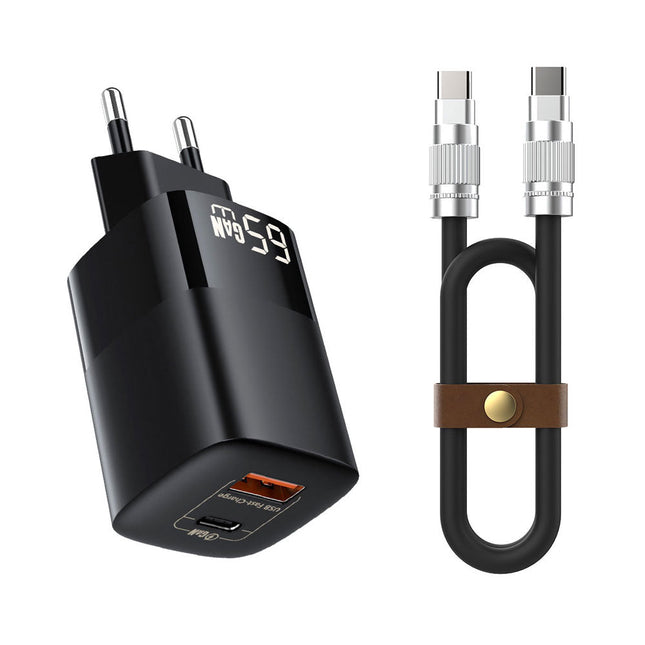
FNIRSI 65 W USB-C PD GaN Power Supply
With this 65 W USB-C PD power supply (with GaN technology) and the included USB-C cable you can start using the FNIRSI HS-01 soldering iron straight away. Of course, you can also use this charger to fast charge your tablets and smartphones via USB-C and USB-A. Included 65 W USB-C PD GaN Power Supply (EU) USB-C cable (1.2 m)
-
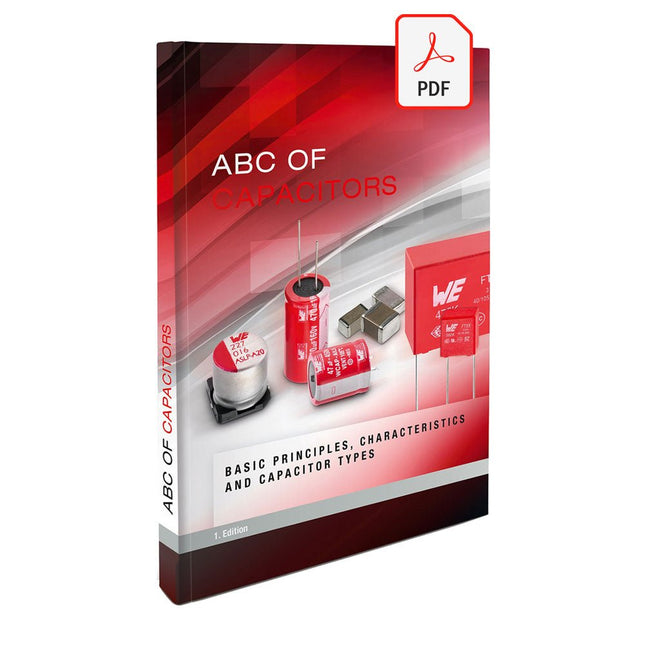
Würth ABC of Capacitors (E-book)
The author Stephan Menzel provides an introduction into capacitor technology and describes the wide range of capacitor types with their properties and parameters. Basic principles This chapter imparts basic knowledge on the relationships between the electric field, permittivity, as well as the structure and operating principles of a capacitor. Capacitor characteristics The electrical parameters and essential characteristics of a capacitor are explained in greater detail for the reader. This extends from the actual capacitance of a capacitor through to the interdependencies. Capacitor types Existing capacitor types and their characteristics are presented. Film, electrolyte and ceramic capacitors are considered in detail.
€ 8,99
Members € 7,19
-

Würth Abc of Power Modules (E-book)
Functionality, structure and handling of a power module For readers with first steps in power management the “Abc of Power Modules” contains the basic principles necessary for the selection and use of a power module. The book describes the technical relationships and parameters related to power modules and the basis for calculation and measurement techniques. Contents Basics This chapter describes the need of a DC/DC voltage converter and its basic functionality. Furthermore, various possibilities for realizing a voltage regulator are presented and the essential advantages of a power module are mentioned. Circuit topologies Circuit concepts, buck and boost topologies very frequently used with power modules are explained in detail and further circuit topologies are introduced. Technology, construction and regulation technology The mechanical construction of a power module is presented, which has a significant influence on EMC and thermal performance. Furthermore, control methods are explained and circuit design tips are provided in this chapter. Measuring methods Meaningful measurement results are absolutely necessary to assess a power module. The relevant measurement points and measurement methods are described in this chapter. Handling The aspects of storage and handling of power modules are explained, as well as their manufacturing and soldering processes. Selection of a power modules Important parameters and criteria for the optimal selection of a power module are presented in this section.
€ 8,99
Members € 7,19
-
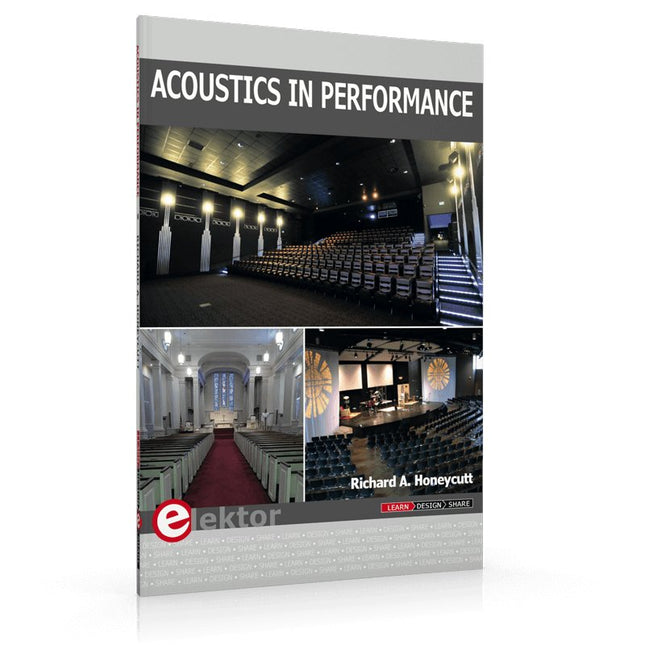
Elektor Publishing Acoustics in Performance
All you need to know about good acoustics and sound systems in performance and worship spaces! Everyone knows that the ability to hear music in balance and to understand speech is essential in any space used for performance or worship. Unfortunately, in the early 21st century, we find that buildings with good acoustics are the exception rather than the rule. Much of the fault leading to this result can be traced to the widespread perception that acoustics is a black art. In fact, scientific acoustics as developed in the last century is a well-defined engineering practice that can lead to predictable excellent results. A basic, non-engineering understanding of acoustics will help building owners, theater managers, ministers and teachers of music, performers, and other professionals to achieve their goals of excellent acoustics in venues with which they work. Performers having a basic understanding of acoustics will be able to make the most of the acoustics of the venue in which they perform. This book helps those responsible for providing good acoustics in performance and worship spaces to understand the variables and choices entailed in proper acoustic design for performance and worship. Practicing acoustical consultants will find the book a useful reference as well. The level of presentation is comfortable and straightforward without being simplistic. If correct acoustical principles are incorporated into the design, renovation, and maintenance of performance and worship venues, good acoustics will be the result.
€ 29,95
Members € 26,96
-

Elektor Digital Acoustics in Performance (E-book)
All you need to know about good acoustics and sound systems in performance and worship spaces! Everyone knows that the ability to hear music in balance and to understand speech is essential in any space used for performance or worship. Unfortunately, in the early 21st century, we find that buildings with good acoustics are the exception rather than the rule. Much of the fault leading to this result can be traced to the widespread perception that acoustics is a black art. In fact, scientific acoustics as developed in the last century is a well-defined engineering practice that can lead to predictable excellent results. A basic, non-engineering understanding of acoustics will help building owners, theater managers, ministers and teachers of music, performers, and other professionals to achieve their goals of excellent acoustics in venues with which they work. Performers having a basic understanding of acoustics will be able to make the most of the acoustics of the venue in which they perform. This book helps those responsible for providing good acoustics in performance and worship spaces to understand the variables and choices entailed in proper acoustic design for performance and worship. Practicing acoustical consultants will find the book a useful reference as well. The level of presentation is comfortable and straightforward without being simplistic. If correct acoustical principles are incorporated into the design, renovation, and maintenance of performance and worship venues, good acoustics will be the result.
€ 24,95
Members € 19,96
-

Great Scott Gadgets Acrylic Case for HackRF One SDR
This clear acrylic case is the official case for the HackRF One board. It can replace the standard black plastic case of the HackRF One. Assembly Instructions Use a guitar pick or spudger to extract the HackRF One circuit board from the black plastic case. Insert one long screw into each corner of the bottom acrylic panel. Secure each long screw with a short (5 mm) spacer on the opposite side of the panel. Place the HackRF One circuit board (facing up) on top of the bottom panel, fitting the ends of the long screws through the corner mounting holes of the circuit board. Secure the circuit board with one long (6 mm) spacer in each corner. Place the top acrylic panel on top of the circuit board, aligning the cutouts with the circuit board’s expansion headers. Secure each corner with a short screw. Note: Do not overtighten! Hand-tighten only at every step.
€ 19,95
Members € 17,96
-

Raspberry Pi Foundation Active Cooler for Raspberry Pi 5
The active cooler provides an alternative cooling solution for users who wish to use their Raspberry Pi 5 under sustained heavy load without a case. It combines a large metal heatsink with a variable-speed blower, again powered and controlled via the fan connector, and attaches to the Raspberry Pi 5 via sprung pins into a pair of mounting holes.























